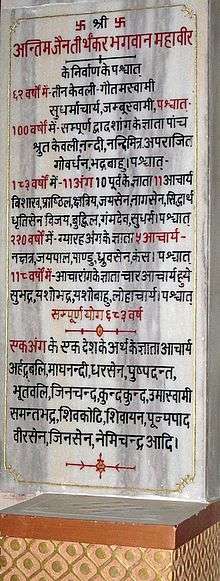Pattavali

| Part of a series on |
| Jainism |
|---|
 |
|
Jain prayers |
|
Ethics |
|
Major sects |
|
Festivals |
|
|
A Pattavali (From Sanskrit patta: seat, avali: chain), Sthaviravali or Theravali, is a record of a spiritual lineage of heads of monastic orders. They are thus spiritual genealogies.[1] It is generally presumed that two successive names are teacher and pupil. The term is applicable for all Indian religions, but is generally used for Jain monastic orders.
There are several famous pattavalis which are often used to establish historical chronologies:[2][3]
- Sarasvatigachchha Pattavali: Pattavali of the Balatkara Gana of Mula Sangh
- Tapagaccha Pattavali: Pattavali of Tapa Gachchha
- Upakesha Gaccha Pattavali: Pattavali of now extinct Upakesha Gaccha.
- Kharataragachha Pattavali: Pattavali of Kharatara Gachchha
Glasenapp notes that although the chronological list mentioned in pattavali are valuable, it is not reliable.[4]
Description
Pattavali states the lineage of Jain monks.[5]
The Jain Monastic Lineages
According to 600 AD inscription at Sravanabelagola, Harivansha Purana, Jambuddvita Pannati and Kalpasutra, the Pattavali (lineage) after Mahavira, 24th tirthankara, is traced as follows.[6] Bhadrabahu was the last leader of the undivided Sangha. After him there were two branches in the lineage. In both branches, some of the oral tradition was gradually lost. The two branches eventually became the two traditions Digambaras and the Svetambaras, although formal recognition of the separation is encountered in the 5th century CE. Kalpasutra gives a lineage starting with Pushyagiri after Vajrasena ending with Kshamashramna Devarddhi, the president of the Vallabhi council. The canonical books of the Svetambaras were produced in writing in this Council. The Kalpasutra also mentions ganas and shakhas established by other disciples of Bhadrabahu, Sambhutavijaya, Mahagiri etc. The Brihat-Kharataragachchha pattavali gives the name of Chandra after Vajrasena, the lineage continues until Udyotana, the founder of Brihadgachcha.
- The Kevalis (those who attained kavalagyana)
- Mahavira Swami
- Gautam Swami
- Lohacharya (Sudharmaswami)
- Jambu Swami
- The Shruta Kevalis (who knew the complete oral texts) According to Digambara tradition:
- Vishnudeva
- Aparajita
- Govardhana
- Bhadrabahu
- The Shruta Kevalis (who knew the complete oral texts) According to Svetambara tradition:
- Prabhava
- Sayyambhava
- Yashobhadra
- Sambhutavijaya
- Bhadrabahu
The Lineages after Bhadrabahu
According to Digambar tradition, the monastic lineage after bhadrabahu was:[7]
- Bhadrabahu, the shruta-kevali
- Visakha, the 10-purvis begin here
- Prosthila
- Kshatria
- Jayasena
- Nagasena
- Siddhartha
- Dhritisena
- Vijaya
- Buddhilinga
- Deva I
- Dharasena
- Nakshatri, 11 angis begin here.
- Jayapalaka
- Pandava
- Dhruvasena
- Kansa
- Subhadra, 1 angis begins here.
- Yashobhadra
- Bhadrabahu II
- Lohacarya II
- Arhadvali, ekangis with partial knowledge of one anga.
- Maghanandi
- Dharasena, see Satkhandagama
- Pushpadanta
- Bhutabali
Arhadvali is said to have been the founder for the divisions of the Mula Sangha.
The lineage from Bhadrabahu according to Svetambara tradition is:[8]
- Bhadrabahu and Sambhutavijaya
- Sthulabhadra
- Mahagiri (268 BC to 168 BC) and Suhastin (222 BC to 122 BC)[9]
- Susthita
- Indradatta
- Dinna
- Sinhagiri
- Vajra (31 BC to 47 CE)[10]
- Vajrasena
See also
Notes
- ↑ Śrī paṭṭāvalī-samuccayaḥ, Vīramagāma, Gujarāta : Śrī Cāritra-Smāraka-Granthamālā, 1933
- ↑ Akbar as Reflected in the Contemporary Jain Literature in Gujarat, by Shirin Mehta, Social Scientist, 1992, p. 54-60
- ↑ Medieval Jaina Goddess Traditions, by John Cort Numen,1987 BRILL, p. 235-255
- ↑ Glasenapp 1999, p. 12
- ↑ Upinder Singh 2016, p. 26.
- ↑ "History of the Digambaras", Jainworld.com, 16 January 1977
- ↑ "History of Digambara".
- ↑ "kalpasutra". Jainworld.com. Retrieved 2012-04-22.
- ↑ Natubhai Shah 2004, p. 46.
- ↑ Natubhai Shah 2004, p. 47.
References
- Nagārāja, Muni (1 January 2003), Āgama Aura Tripiṭaka: Eka Anuśilana, Concept Publishing Company, ISBN 978-81-7022-731-1
- Glasenapp, Helmuth Von (1999), Jainism: An Indian Religion of Salvation, Delhi: Motilal Banarsidass, ISBN 81-208-1376-6
- Cort, John (2010) [1953], Framing the Jina: Narratives of Icons and Idols in Jain History, Oxford University Press, ISBN 978-0-19-538502-1
- Shah, Natubhai (2004) [First published in 1998], Jainism: The World of Conquerors, I, Motilal Banarsidass, ISBN 81-208-1938-1
- Singh, Upinder (2016), A History of Ancient and Early Medieval India: From the Stone Age to the 12th Century, Pearson Education, ISBN 978-93-325-6996-6